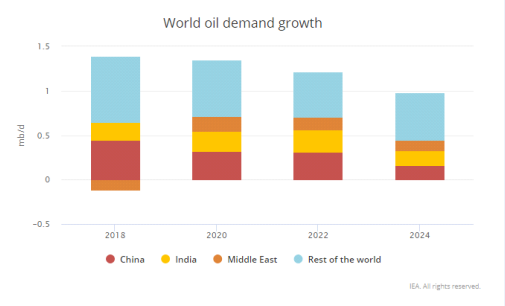As iea implies in recently-released Oil 2019 Analysis and Forecast to 2024, investment on upstream has been rising for a third straight year, which is predicated to grow by 4% by the end of 2019.
The industry’s strong faith in market is backed by a solid demand growth, mainly from emerging economies like India and China. Consequently, oil & gas production is predicted to rise in the near future to satisfy the growing demands.

Figure 1: World oil demand growth prediction by iea
However, Russia and Middle East, as two major energy resource exporters in the world, face more difficulties when it comes to oil & gas exploration and production. Their unique geological conditions result in extreme weather and harsh working environment, which require more stability for equipment performance and operation. For companies in these areas, there is a big challenge to guarantee that their plants are dependable and have no unanticipated shutdowns.
Jereh, as a leading oil & gas solution provider, is dedicated to solving the challenges that customers face, with its fit-for-purpose solutions. Its equipment is not only able to work stably at -47℃ in Russia but also to shelter operators from scorching sun in tropical rainforest or mighty desert.
In the arctic regions such as Siberia, there is a large reserve of high-viscosity oil. The high viscosity and -40℃ low-temperature environment usually bring up higher requirements to the equipment. On the contrary, the high temperature up to 50℃ in the tropical regions also challenges the performance of equipment.
To help customers succeed in the extreme conditions, Jereh engineers go deep into the fields for on-site investigation to ensure the excellent performance of the equipment. For instance, Jereh’s self-developed CTU is capable of running steadily under -43℃ and up to 55℃, catering to various working conditions according to customers’ differentiated demands.

Figure 2: Jereh CTU working in freezing environment.
On the other hand, meeting the environmental requirements is also a big challenge for many oil & gas players nowadays. Global awareness of environment protection is gaining strong gradually, which demands the industry to operate in a more environmentally-friendly way.
For example, IMO 2020 is about to come into effect in several months. It has stirred some controversy since it is considered to have the power of triggering a shake-up in the product markets. As an act to eliminate high sulfur fuel oil (HSFO), it is one of the first few actual moves within the industry to help improve environmental issues. Being the main consumer of energy and water resources, the oil & gas industry is subject to severe environmental standards.
Jereh's newly-launched electric frac spread has attracted lots of attention the year for being environmental and economic at the same time. Totally powered by electricity, the equipment is proved to reduce fuel consumption by 46.7%, which will help improve the environment by lessening greenhouse gas emission. Meanwhile, it also features little noise and is capable of recycling flow-back fluids, greatly easing the negative impacts that oil & gas operation brings along.
Visit www.jereh.com to know more about how we can help you overcome the major challenges in the oil and gas industry.






